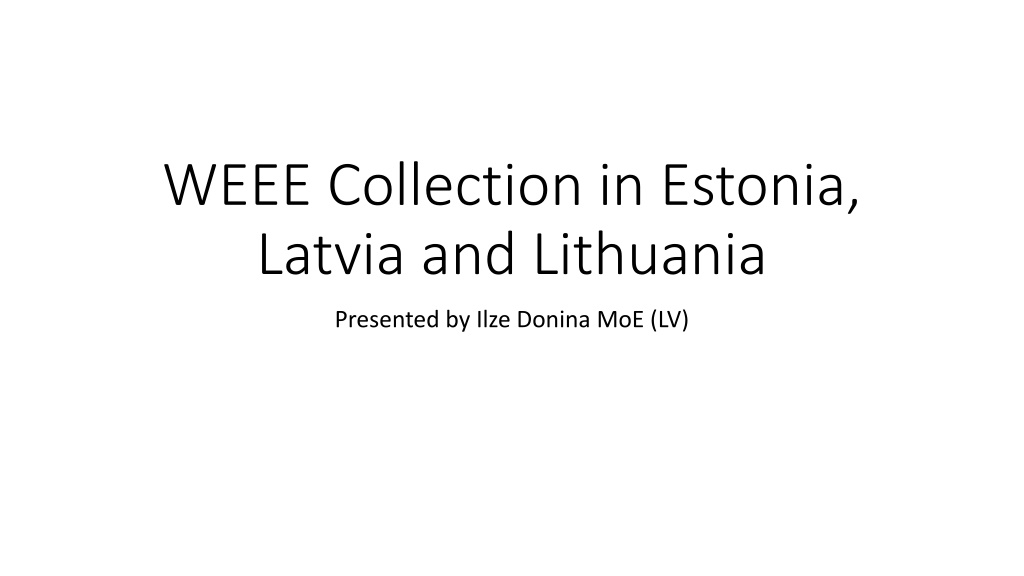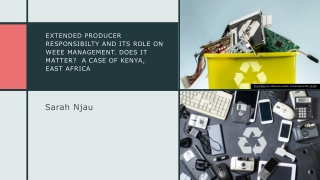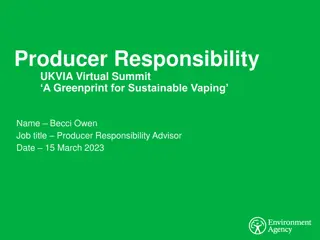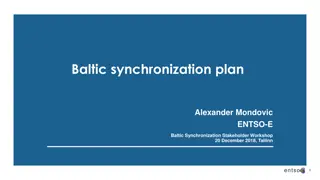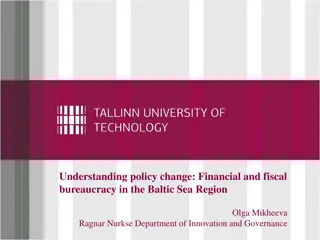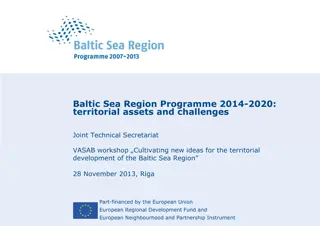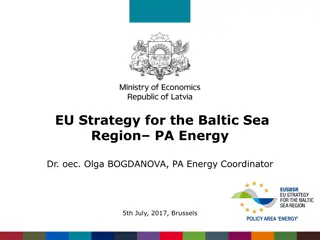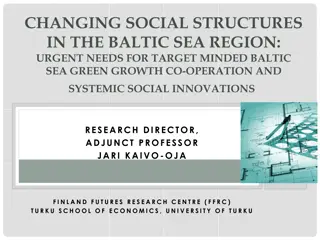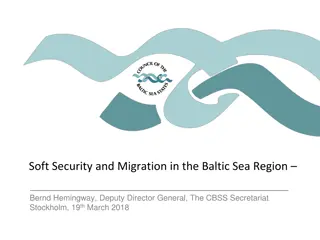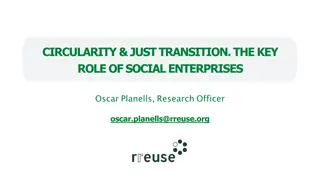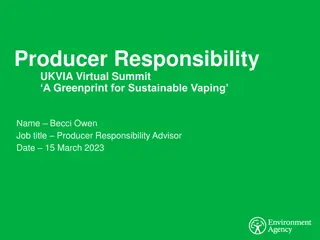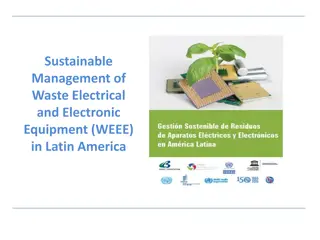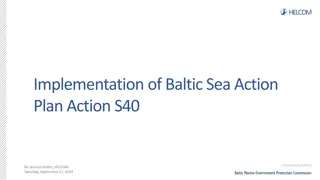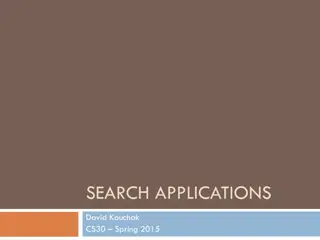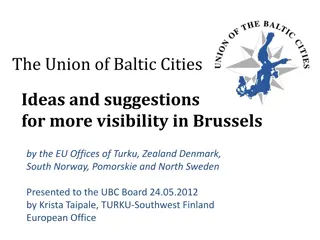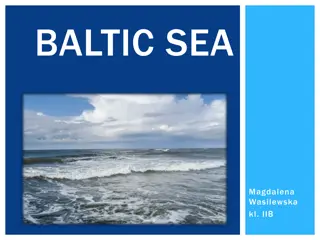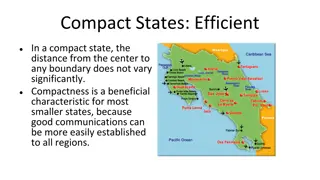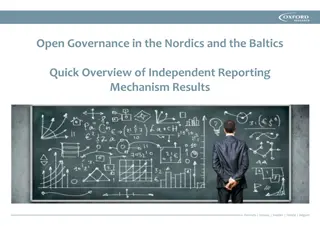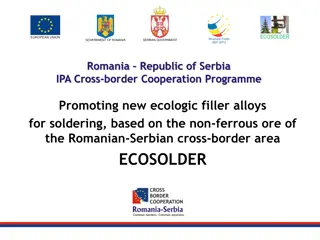Overview of WEEE Collection in Baltic States
This presentation explores the WEEE (Waste Electrical and Electronic Equipment) collection practices in Estonia, Latvia, and Lithuania. It covers the targets set by the WEEE directive 2012/19/EU, the setup of collection systems, and the results achieved. The content delves into the minimum collection rates mandated by the directive over the years, with a focus on the specific circumstances and derogations granted to Latvia and Lithuania due to infrastructure constraints. Additionally, it provides details on the number of producer responsibility organizations and registered producers in each country. The fulfillment of WEEE collection targets as per Directive 2002/96/EC is also examined, showcasing the collected amounts of WEEE from households in the respective years.
Download Presentation

Please find below an Image/Link to download the presentation.
The content on the website is provided AS IS for your information and personal use only. It may not be sold, licensed, or shared on other websites without obtaining consent from the author.If you encounter any issues during the download, it is possible that the publisher has removed the file from their server.
You are allowed to download the files provided on this website for personal or commercial use, subject to the condition that they are used lawfully. All files are the property of their respective owners.
The content on the website is provided AS IS for your information and personal use only. It may not be sold, licensed, or shared on other websites without obtaining consent from the author.
E N D
Presentation Transcript
WEEE Collection in Estonia, Latvia and Lithuania Presented by Ilze Donina MoE (LV)
Content of the presentation WEEE collection targets as set by WEEE directive 2012/19/EU Set-up of WEEE collection systems in Estonia, Latvia and Lithuania Results of applied WEEE collection systems
WEEE collection targets set by directive 2012/19/EU Until 31 December 2015 at least 4 kilograms on average per inhabitant per year of WEEE from private households or the same amount of weight of WEEE as was collected in that Member State on average in the three preceding years, whichever is greater. From 2016, the minimum collection rate shall be 45 % calculated on the basis of the total weight of WEEE collected in a given year, expressed as a percentage of the average weight of EEE placed on the market in the three preceding years From 2019, the minimum collection rate shall be 65 % of the average weight of EEE placed on the market in the three preceding years, or alternatively 85 % of WEEE generated on the territory of that Member State.
WEEE collection targets set by directive 2012/19/EU By way of derogation ...Latvia, Lithuania... may, because of their lack of the necessary infrastructure and their low level of EEE consumption, decide to: (a) achieve, from 14 August 2016, a collection rate that is lower than 45 % but higher than 40 % of the average weight of EEE placed on the market in the three preceding years; and postpone the achievement of the collection rate referred to in the second subparagraph of paragraph 1 until a date of their own choice which shall not be later than 14 August 2021. (b)
Number of Producer responsibility organisations and Number of Producer responsibility organisations and number of registered producers number of registered producers Estonia Latvia Lithuania Number of Producer responsibility organisations 3 6 3 Number of registered producers 500 1209 1068
Fullfillment Fullfillment of of WEEE 2002/96/EC 2002/96/EC WEEE collection collection targets targets set set in in Directive Directive Collected amounts of WEEE from households (kg/per capita): 2009 2010 2011 2012 2013 Estonia 3,53 4,186 4,93 4,064 3,041 Latvia 1,949 1,988 1,888 1,885 2,366 Lithuania 2,159 2,85 3,779 4,477 5,204
Development Development of of WEEE WEEE collection collection targets targets Year Estonia Latvia Lithuania Quant. Qual. 4 kg/capita (25 % PoM, 50% light.) 4 kg/capita (25 % PoM, 50% light.) 4 kg/capita (25 % PoM, 50% light.) 4 kg/capita (25 % PoM, 50% light.) 4 kg/capita (25 % PoM, 50% light.) 4 kg/capita (25 % PoM, 50% light.) 4 kg/capita (25 % PoM, 50% light.) 2009 4kg/capita 27 % PoM - 2010 4kg/capita 30-44 % PoM - 2011 4kg/capita 44-56 % PoM - 4kg/capita 2012 50% PoM 40% PoM from July 1st5kg/capita 2013 50% PoM 40% PoM 4kg/capita 2014 50% PoM 40% PoM from July 1st5kg/capita 2015 5 kg/capita 40-55 % PoM 30-45 % PoM 2016 45 % PoM 40,5 % PoM 45-60 % PoM 35-50 % PoM 2017 52 % PoM 50-65 % PoM 40-55 % PoM 2018 59 % PoM 2019 65 % PoM 2021 - 65 % PoM
Requirements Requirements for for set set- -up up of of WEEE WEEE collection collection systems systems Estonia Latvia Lithuania Vilnius collection point per 80000 inh. Klaipeda and Siauliai cities - 1 collection point per 40 000 inh. Panevezys and Alytus cities - 1 collection points per 30 000 inh. Cities with population 15 000 and 50 000 inh. - 2 collections points; Other cities, towns and villages - 1 collection point each and Kaunas - 1 Requirements Minimum one collection point per local authority with 3500+ inh. * Each PRO has to establish at least 3 WEEE collection points in each waste management region (10 regions), each in different parish or town *in case of WEEE from private households Number of collection points 100 165
Requirements for information campaigns Estonia Producer has to make a public information campaign through different media channels like county newspapers, state-wide media channels (TV, radio) or external advertising. Producer has to use at least two different media channels. Minimum duration for information campaign is 10 days. Latvia PRO and individual producers enjoying exemption of NRT payment are obliged to provide for: at least 4 communication activities in calendar year (including information activities, educational activites, public involvement activities) in order to inform general public and to involve it in the management of WEEE. Lithuania Not less than 3 per cent of the revenue has to be paid by the organization public education awareness raising related to waste issues. for and management
Amounts Amounts of of collected collected WEEE, WEEE, tons tons 18,000 16,000 14,000 12,000 10,000 Estonia Latvia 8,000 Lithuania 6,000 4,000 2,000 0 2007 2008 2009 2010 2011 2012 2013 Source: Eurostat Source: Eurostat
Amounts Amounts of of collected collected WEEE, WEEE, tons tons 200,000 180,000 160,000 140,000 Estonia 120,000 Latvia Tons 100,000 Lithuania Poland 80,000 Finland 60,000 40,000 20,000 0 2007 2008 2009 2010 2011 2012 2013 Source: Eurostat Source: Eurostat
WEEE collected, kg/per capita WEEE collected, kg/per capita 12 10 8 Estonia kg/inh. Latvia 6 Lithuania Poland Finland 4 2 0 2007 2008 2009 2010 2011 2012 2013 Source: Eurostat Source: Eurostat
WEEE WEEE collected collected vs. vs. PoM PoM(%) (%) 70% 60% 50% Estonia 40% Latvia Lithuania 30% Poland Finland 20% 10% 0% 2007 2008 2009 2010 2011 2012 2013 Average Source: Eurostat Source: Eurostat
Collection rate of large household appliances (LHA) Collection rate of large household appliances (LHA) 60% 50% 40% Estonia Latvia 30% Lithuania Poland 20% Finland 10% 0% 2010 2011 2012 2013 Source: Eurostat Source: Eurostat
Collection rate of small household appliances (SHA) Collection rate of small household appliances (SHA) 60% 50% 40% Estonia Axis Title Latvia 30% Lithuania Poland 20% Finland 10% 0% 2010 2011 2012 2013 Source: Eurostat Source: Eurostat
Collection rate of consumer equipment (CE) Collection rate of consumer equipment (CE) 180% 160% 140% 120% Estonia 100% Latvia Lithuania 80% Poland 60% Finland 40% 20% 0% 2010 2011 2012 2013 Source: Eurostat Source: Eurostat
Collection rate of IT and telecommunications equipment (ITC) Collection rate of IT and telecommunications equipment (ITC) 120% 100% 80% Estonia Axis Title Latvia 60% Lithuania Poland Finland 40% 20% 0% 2010 2011 2012 2013
Collection rate of lamps Collection rate of lamps 90% 80% 70% 60% Estonia 50% Latvia Lithuania 40% Poland Finland 30% 20% 10% 0% 2010 2011 2012 2013 Source: Eurostat Source: Eurostat
Collection Collection rate rate of of lighting lighting equipment equipment 60% 50% 40% Estonia Latvia 30% Lithuania Poland 20% Finland 10% 0% 2010 2011 2012 2013 Source: Eurostat Source: Eurostat
